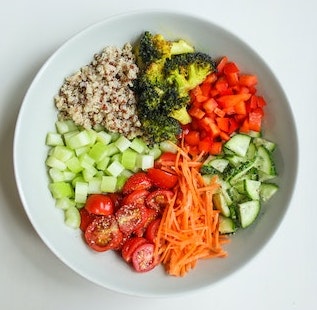Dog Food is for Dogs
But fiber. That’s food for the gut microbiome.
Fiber 101
We’ve all heard that we should get plenty of fiber from our diet every day to support heart health, healthy weight management, and gastrointestinal function. Despite these recommendations to eat a high-fiber diet, and many food manufacturers claiming that their products are “high in fiber,” it’s still a commonly misunderstood food component. Yet it’s one that deserves some explanation considering how many important roles it plays in the body. Consider this your beginner’s guide to fiber, including what foods to eat and why it’s so important to consume daily.
What is it?
Fiber is a non-starchy type of carbohydrate found predominantly in plant foods, though it can also be found in some shellfish shells or manmade. Us humans can’t digest fiber, we’re missing the enzymes responsible for this. Instead, it passes through our guts fully intact, landing in the mouths of the microbes in our guts who happily munch away, and we all (usually) reap the benefits.

Benefits of fiber
Beneficial, happily munching microbes = they reproduce. Since adequate fiber leads to beneficial gut microbes in adequate quantities, they give us health-promoting side effects like extra nutrients, balancing the immune system, increased nutrient absorption, and keeping our bowels regular. We even see thai in the research: Increased fiber intake has been associated with decreased inflammation and lower risk of various cancers, as well as improved cholesterol numbers, increased satisfaction after eating, and improved removal of toxins from the gut.
Consuming fiberThe USDA recommends at least 28 g total fiber per day for women, 38 g for men, and 25 g for children aged 4-8 years. However, at least 35 to 50 g per day for adults would be considered optimal. A Western dietary pattern contributes about 5 to 15 g of fiber per day (and children commonly consume less than 5 g per day), while in some cultures where traditional foods are consumed, people may eat over 40 g per day.
Fiber should always be added slowly to the diet to prevent constipation, gas, cramping, and bloating (since microbes will be more happily munching and proliferating!). Aside from encouraging an increase in dietary fiber from whole fruits, vegetables, whole grains, and legumes, sometimes functional (supplemental) fiber can be added. (Dietary fiber is preferred where possible, as some supplemental functional fibers have been found to create gastrointestinal symptoms in some individuals.) While increasing fiber, water must also be increased to at least 64 fluid ounces per day, and more as needed.
But watch out! For those with small intestinal overgrowths, the addition of dietary fiber may be contraindicated as it will make symptoms worse!

Where to find fiber
Fiber can be found in all plant foods, from whole grains & seeds, to beans & legumes, to fruits & veggies. Different plants product different fiber-containing foods, and so this is yet another reason to eat a diverse diet! Some great sources of fiber include all types of lentils and beans, winter squash, artichoke hearts, prunes, mushrooms, konjac root (Miracle Noodles), whole grains, brown rice, wheat and rice bran, barley, cabbage, bamboo shoots, hearts of palm, and celery. But all plant foods will have at least some fiber in them!
Remember. We don’t just eat for ourselves. We’ve got trillions of microbes we also need to feed!
